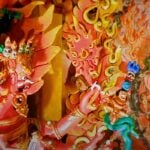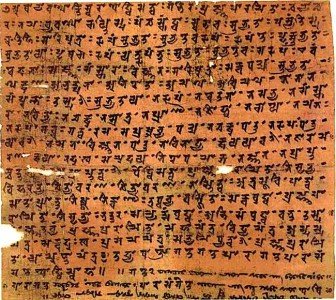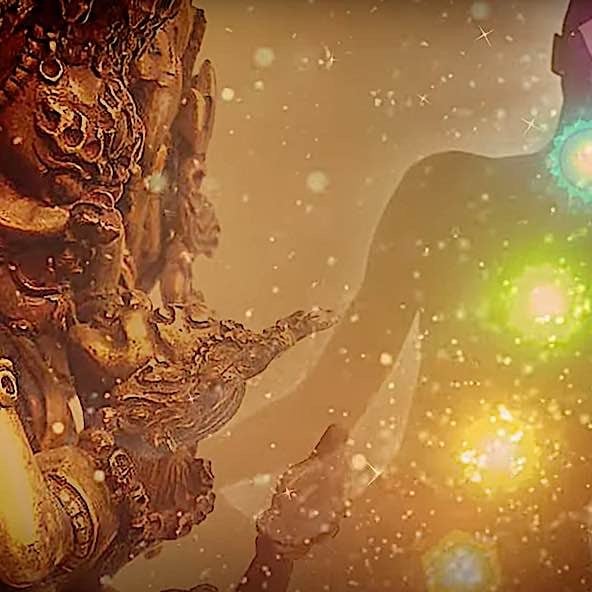Much More-Than-Six-Words of Advice — Mindfulness of Body; Anger; and Healing Through Meditation (Mahamudra Teachings Session 2)
“Don’t recall, don’t imagine, don’t think, don’t examine, don’t control, rest,” Tilopa’s six word’s of advice to Naropa, could be said to be an important concept for understanding Mahamudra.[1]
By Lee Kane
Tilopa’s famous “six words of advice” was clearly a theme emphasized consistently throughout Zasep Tulku Rinpoche’s wonderful introductory Mahamudra teachings in Owen Sound. The very essence of mindfulness is captured in the longer explanation of the six words: “Let go of what has passed; let go of what may come; let go of what is happening now; don’t try to figure anything out; don’t try to make anything happen, relax right now and rest.” [2]
You could say that Rinpoche’s one-day retreat on Mahamudra, while much more than six words, in essence condenses down to Tilopa’s advice. The key difference, Rinpoche delivered powerful tips on how-to understand this seemingly simple, yet profound advice. Rinpoche brought the teachings to life with insights and anecdotes and advice, focusing on the key elements of
- one-pointedness (in Sanskrit ekagra, or in Tibetan rtse gcig)
- simplicity (in Sanskrit nishprapancha, or in Tibetan spos bral)
- one taste (in Sanskrit samarasa, or in Tibetan ro gcig)
- non-meditation (in Sanskrit abhavana, or in Tibetan sgom med) — to not be or hold either object of meditation nor the meditator.
In session 1 — see Session 1 of the introductory Mahamudra Teachings coverage — Rinpoche explained that Mahamudra basic practices fit into life just as it is. He instructed the full house on how to practice Anapanasati meditation, the “mindfulness of breathing.”
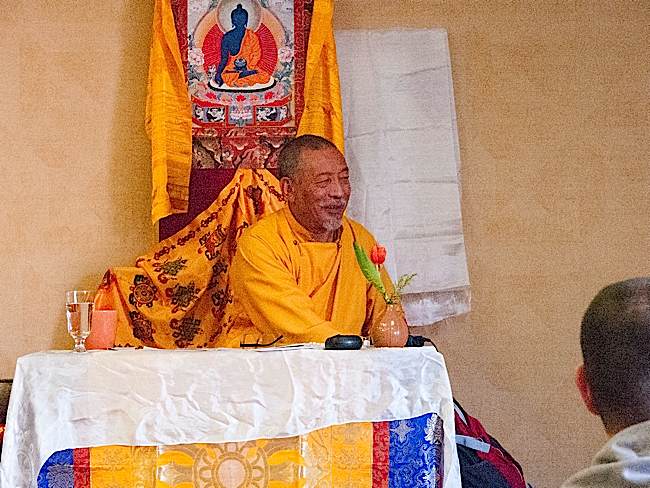
- Part 2 of introductory Mahamudra, teachings from Zasep Tulku Rinpoche
- For Part 1, “More Than Six Words” please visit>>
- For Part 3, “Mindfulness of Feelings” please visit>>
Rinpoche described Anapanasati as “wonderful. It doesn’t require religion, even though it was taught by the Buddha.” He encouraged us to refer to the Mahasatipatthana Sutta, “the great mindfulness Sutta,” which taught how to establish the mindfulness of body (Kaya), sensations (Vedana), mind (Citta) and mental contents (Dhamma).
Mindfulness of Body
“Shakyamuni Buddha taught the mindfulness of body first,” Rinpoche explained, at the beginning of session two. “Why body first? Because this is the object we see. We see body first.”
He brought chuckles from the audience as he illustrated with is own body: “Oh, I’ve got a goatee. I’ve got grey hair. I’m getting old. I’ve got some wrinkles. I can feel my knees and ankles, my stiffness.” He explained that because we see all of this first, our first perception, we should practice mindfulness of body first.
“When you practice mindfulness of body, you don’t judge. We don’t judge your body. You don’t compare your body with somebody else… The way you practice mindfulness of body is you observe your body just as it is.”
“There’s a meditation we call, in modern language, ‘body scanning.'” He compared it to an impartial review of body with ultrasound, except we do it mentally, our mind examining our body as it is now. The translation of the ancient term for this meditation translates as “sweeping meditation.”

He instructed us on sweeping or scanning meditation. “You sit, focus your mind on the crown, then on your face, then on your throat, chest, stomach, thighs, knees, ankles, toes and so on.” Just mindfully sweep the body as an observer, slowly. As you do this, the muscles and tension in the body tends to let go, releasing the tension from recent past experiences or future anticipated experiences. By staying mindful of the body now — as you observe the tension in shoulders, arms, knees, ankles — the muscles tend to slowly relax.
Body and Mind Come Together
“Your body will relax. And you are with the body, your mind and body together, here and now. Sometimes, it seems not so relaxing. You notice and feel aches and pains… you notice what is wrong with your body—you don’t want to see that! Fear and issues can come up. But it’s an important meditation. We have to know ourselves, feel ourselves.”
Rinpoche joked that “we don’t know our bodies. That’s why we’re always going to the doctor to do ultrasounds. Here, we become our own doctor, healer, therapist. Without judging, just observing.
“The point here is to bring mind and body together, cultivate mindfulness of body by observing the body now, and become one in body and mind.”
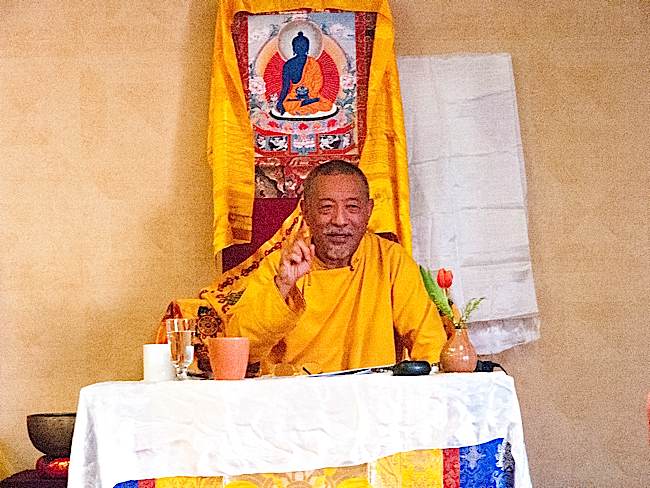
Rinpoche explained that the same obstacles will arise in body mindfulness as bothered us in the previous (session 1) breath mindfulness meditation: wandering mind, and torpid mind. The remedy is the same. Just observe you are wandering, and bring yourself back to the body part you were mindfully observing. Or observe you are drifting into sleepiness, and mindfully bring yourself back.
The group of participants were invited to ask questions, and then we performed our own mindfulness of body meditation under Rinpoche’s guidance.
Heart Sutra: Form is Emptiness and Emptiness is Form
One of the students asked Rinpoche to elaborate on relative truth (or conventional truth) and absolute truth. After thanking him for the question, Rinpoche began his answer with reference to the Heart Sutra.
“In this sutra, two of Buddha’s disciples had a dialogue. One of the disciples, Avalokitesvara speaks on emptiness:
‘In this case, Shariputra, form is emptiness and emptiness is itself form; emptiness is not different from form, and form is not different from emptiness; that which is form is emptiness, and that which is emptiness is form. So it is for perception, conception, volition and consciousness.”
Rinpoche explained that what we seem to see as our physical body, or a vase of flowers, or a glass of water are “form”— a conventional truth or relative truth. He explained, if we need a drink, we drink water. “We don’t deny the existence of conventional truth.”
Analytical Meditation: Two Truths
In explaining relative versus absolute truth, Rinpoche invited us to use analytical meditation. “I look at my body, and ask myself the question, what is my body? … You do a scanning meditation and try to find your body. When you scan your skin, you ask, is that my body? No, it’s skin, not body. Then you look at your bones, and likewise every part of your body.” If you scrutinize the body this way you’ll find body parts, but not body. Even those body parts have components if you scan those body parts. “To be body, it has to be the ‘whole’ body, all the parts. If you really look, you can’t find one thing that is your body. What we call body is just a ‘label’. A name. Imputing a label.” Therefore, “yes it’s a body” in relative truth, “but when you search for the absolute body, you can’t find it. We can call this the emptiness of our body.” It only exists by virtue of it’s label.
“A good example is your car. If you take that car apart, and everything is just parts, there is no car. Just car parts. You put it back together, and then label it Hyundai, you have a Hyundai. But if you switch the labels [to Honda] is it now a Honda? It’s all labels. There is no independent existence. That’s only one way to look at emptiness.”
“Emptiness and form co-exist,” he explained. The car relatively exists, but is, in absolute terms, only a label. It is made up of parts, and defined only by a relative label.
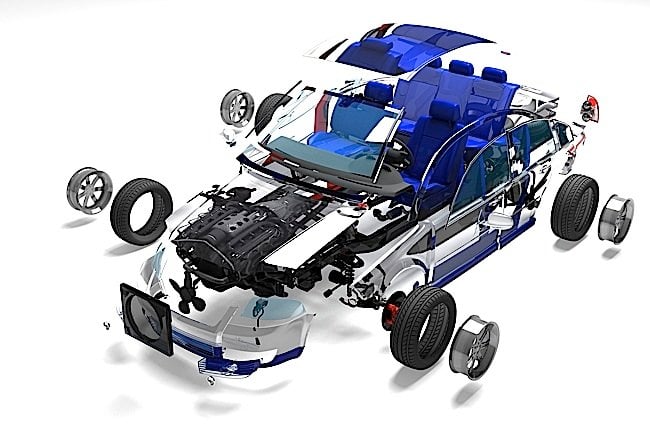
Anger: Does it Exist?
A student asked Rinpoche to apply the Two Truths to something like an emotion. Rinpoche answered, “Anger is a good example.” He dissected anger, to illustrate: “I’m angry. So, I try to observe my anger. What kind of anger is this? Just observing, looking at anger, observing, and soon I analyze why I’m angry. I say to myself, I’m angry with myself! I feel I’m angry with myself. I ate too much food, or I failed an exam, or I’m late for work. It’s not a big deal.” He explained that this is relative anger. “That’s a real thing, I’m really angry. But then, you keep looking at your anger,” analyzing it the same way as the car, you realize, “that anger concept is a label.”
For example, if we’re angry with self for eating too much—when we’re supposed to be on a diet—then you analyze that anger and you find multiple feelings: “I feel disappointment. I feel shame. I feel embarrassed. I feel I’m not doing the right thing. I shouldn’t do ‘this’, I shouldn’t do ‘that.’ That’s also my expectations. So, there are many layers and layers…so where is anger? There’s no real anger. Anger is just a concept, a label imputed on all these layers, thoughts, expectations.”
Knowing this you may realize, “I don’t have to be angry with myself. All I have to do is be more mindful. Be mindful of eating. Of not eating. Cultivate more mindfulness, and there’ll be no need to be angry.”
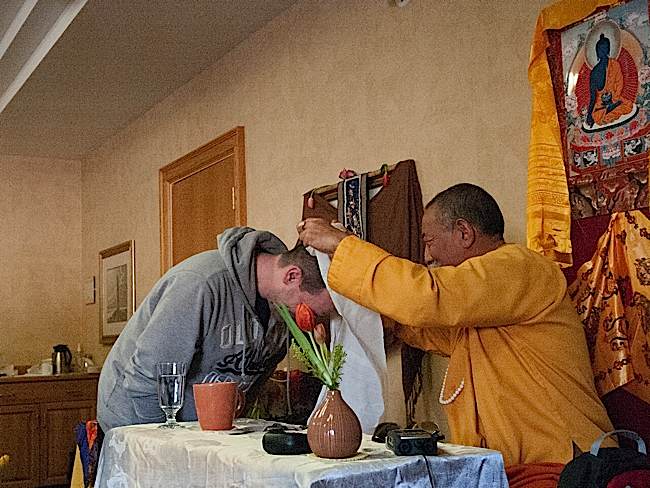
Healing Through Meditation
Another student asked about “healing your body with meditation. Instead of using conventional doctors, using their mind to heal, and being able to self heal through body scanning and mindful meditation?”
Rinpoche’s answer was cautious, probably due to the qualifier in her question, “instead of using conventional doctors” — which it soon became clear he did not agree with.
Rinpoche said, “Yes, I have seen, and I have heard of healers, and I know healers — I know lamas and yogis who do healing for themselves and other people. They do healing without taking medicine. They are very powerful and can heal through visualization, mantras, prayers and through meditation. BUT—” he said, his voice rising, “to do that, to reach that state, you have to have profound realizations, lots of experience, years of experience. It’s not so easy.
“It depends also on the nature of your illness. Some illnesses—you cannot. And some illnesses, you can. Depends on the illness. Not every illness can be cured by our mind.” Ultimately, “it all depends on you. You take responsibility.”
“For example, if someone has an illness, cancer, it may not be curable by [conventional] medicine. With meditation, it’s still not curable. But the power of healing meditation can help you to live with it, without so much agony, pain, anger, blame… Meditation helps you learn to live with it.”
“So, yes, meditation can help. Certain illnesses can be healed by the power of meditation, and prayer.” The clear subtext was — see your doctor.
![Much More-Than-Six-Words of Advice — Mindfulness of Body; Anger; and Healing Through Meditation (Mahamudra Teachings Session 2) 7 "For example, if someone has an illness, cancer, it's may not be curable by [conventional] medicine. With meditation, it's still not curable. But the power of healing meditation can help you to live with it, without so much agony, pain, anger, blame... Meditation helps you learn to live with it."](https://buddhaweekly.com/wp-content/uploads/2015/04/Buddha-Weekly-Meditation-against-sunrise-sky-Buddhism.jpg)
A Funny Story: My Student the Smoker
Rinpoche, always one to pepper his answers with often-funny anecdotes, said, “I’ll tell you a story. I used to live in Australia back in the late seventies. In 1984, I went back there for a visit. I know one lady, she smoked a lot. Doctors said ‘you’ve got two years to live.’
“She was scared and came to me. I taught her meditation, visualization and Tara practice. And now, how many years is it? 32 years later, she’s still alive! She’s still running around smoking!” The audience erupted in laughter.
The last time he saw her, “I said to her, ‘how are your lungs?’ She said, ‘like a good chimney’,” he added, to more laughter. “She said, ‘I got thirty years, no complaints, now every day is a bonus.’ So, that’s the power of meditation, of healing, of Tara, I believe.”
(For more information on Tara and Tara practice refer to this feature>> or on White Tara here>>)
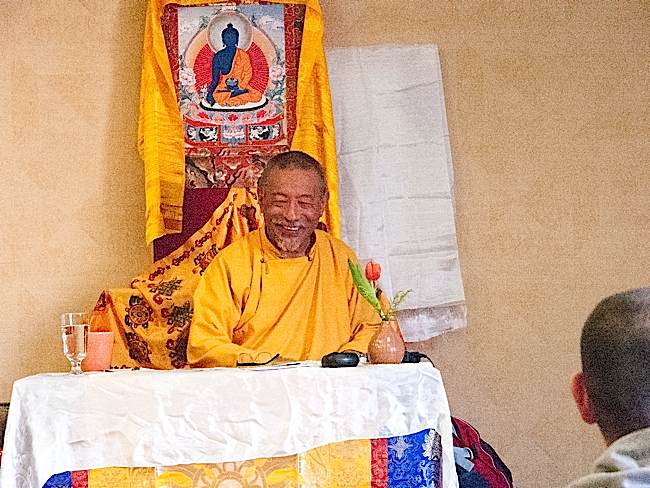
Mahamudra Meditation: Resting the Mind in Natural State
Rinpoche asked us to prepare for the next group meditation, resting the mind in the natural state. “As I said before, today our minds are so busy. Not only the body, but the mind is tired! Our mind gets cloudy. Agitated… This is not our natural state. Due to the environment, due to conditioning, expectations that you should be busy, doing this, doing that, obligations, responsibilities—so, the mind gets quite tired. Not only that — exhausted.”
Rinpoche explained this is why the meditation method “resting the mind in natural state” is important today.
In a gentle voice, he guided: “Sit comfortably on the cushion, relax your body, and keep your mind here, in this moment. Do not go to the past. Don’t think about past events. Don’t think about yesterday, last month, last year, ten years ago, do not go to the past. Do not go to the future. Tomorrow, next month, ‘I want to do this or that’ — don’t go to the future. Do not analyze anything. Do not investigate. Be here and now. In the present moment. Keep your mind like a mirror, an empty mirror. An empty mirror only reflects. Or, keep your mind like an empty sky. This way, you rest your mind in a natural way.” He cautioned us not to examine the question ‘what is mind’ — that session was planned for the afternoon — but simply to rest the mind in it’s natural state. Unlike mindfulness of breathing, from session one, here we were asked to simply rest the mind in the now.
Watch for Session 3 of Mahamudra Introduction.
Read the notes from Session 1 here>>
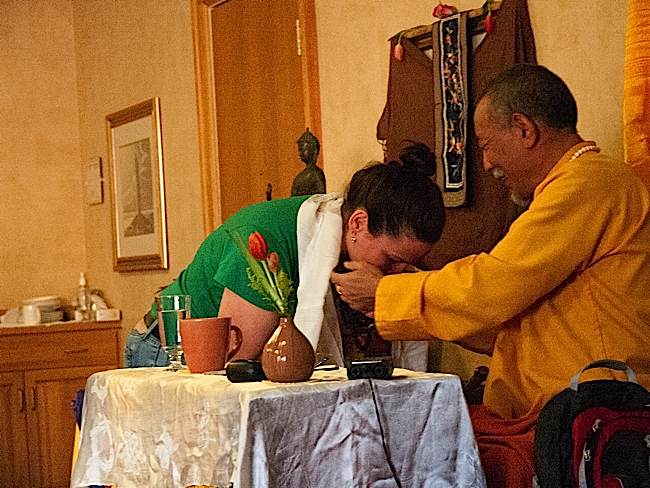
About Zasep Tulku Rinpoche
Rinpoche is the spiritual guide for Gaden for the West—with several meditation centres across Canada, Australia and the United States. He travels extensively, teaching several times each year in parts of Canada, Australia, the US and Mongolia. Rinpoche received many teachings and initiations from other great lamas, legendary teachers such as: Yongzin Trijang Rinpoche, His Holiness Kyabje Ling Rinpoche, Venerable Geshe Thupten Wanggyel, Kyabje Zong Rinpoche, Venerable Lati Rinpoche, Venerable Tara Tulku Rinpoche and Venerable Khalkha Jetsun Dampa Rinpoche. (More about Zasep Tulku Rinpoche>>)
About Host Theodore Tsaousidis
Theodore Tsaousidis has been conscious of his spiritual journey from an early age. Born in a rural community in Greece surrounded by mountains and valleys, he was profoundly shaped by nature and the ancient tradition of village elders and healers. His connection to nature and the spirit world is an integral part of who he is – as is his dedication to the Zen training he has followed for 30 years. He is also blessed by the guidance of the Venerable Zasep Tulku Rinpoche. His healing and shamanic sharing stem from, his cultural roots, personal experience. and Tibetan and Buddhist traditions. Theodore sees shamanism and meditation as a great alchemy for the healing of self and other.
NOTES
[1] Translated from the Tibetan “mi mno, mi bsam, mi shes, mi dpyod, mi sgom, rang sar bzhag”
[2] UnfetteredMind.org https://www.unfetteredmind.org/six-words-of-advice/
More articles by this author

Offering Light for Saga Dawa Duchen and the Month of Merits: Buddha’s Birthday, Enlightenment and Paranirvana 100 Million Merit Day

Who is my Enlightened Life Protector Based on Tibetan Animal Sign Zodiac in Buddhism? According to Mewa, Mahayana tradition and Kalachakra-based astrology (with Mantra Videos!)
Search
Latest Features
Please support the "Spread the Dharma" mission as one of our heroic Dharma Supporting Members, or with a one-time donation.
Please Help Support the “Spread the Dharma” Mission!

Be a part of the noble mission as a supporting member or a patron, or a volunteer contributor of content.
The power of Dharma to help sentient beings, in part, lies in ensuring access to Buddha’s precious Dharma — the mission of Buddha Weekly. We can’t do it without you!
A non-profit association since 2007, Buddha Weekly published many feature articles, videos, and, podcasts. Please consider supporting the mission to preserve and “Spread the Dharma." Your support as either a patron or a supporting member helps defray the high costs of producing quality Dharma content. Thank you! Learn more here, or become one of our super karma heroes on Patreon.
Lee Kane
Author | Buddha Weekly
Lee Kane is the editor of Buddha Weekly, since 2007. His main focuses as a writer are mindfulness techniques, meditation, Dharma and Sutra commentaries, Buddhist practices, international perspectives and traditions, Vajrayana, Mahayana, Zen. He also covers various events.
Lee also contributes as a writer to various other online magazines and blogs.






